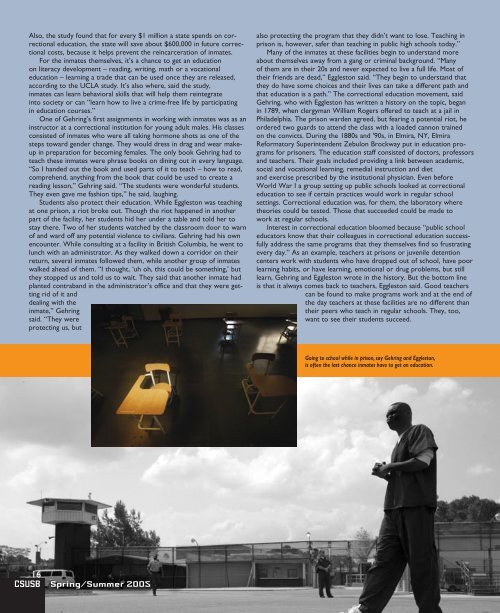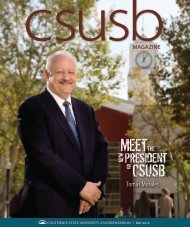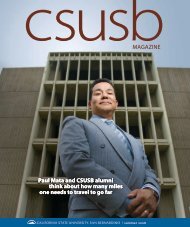CalMagSpr05 ind.indd - CSUSB Magazine - California State ...
CalMagSpr05 ind.indd - CSUSB Magazine - California State ...
CalMagSpr05 ind.indd - CSUSB Magazine - California State ...
- TAGS
- csusb
- magazine.csusb.edu
You also want an ePaper? Increase the reach of your titles
YUMPU automatically turns print PDFs into web optimized ePapers that Google loves.
Also, the study found that for every $1 million a state spends on correctional<br />
education, the state will save about $600,000 in future correctional<br />
costs, because it helps prevent the reincarceration of inmates.<br />
For the inmates themselves, it’s a chance to get an education<br />
on literacy development – reading, writing, math or a vocational<br />
education – learning a trade that can be used once they are released,<br />
according to the UCLA study. It’s also where, said the study,<br />
inmates can learn behavioral skills that will help them reintegrate<br />
into society or can “learn how to live a crime-free life by participating<br />
in education courses.”<br />
One of Gehring’s first assignments in working with inmates was as an<br />
instructor at a correctional institution for young adult males. His classes<br />
consisted of inmates who were all taking hormone shots as one of the<br />
steps toward gender change. They would dress in drag and wear makeup<br />
in preparation for becoming females. The only book Gehring had to<br />
teach these inmates were phrase books on dining out in every language.<br />
“So I handed out the book and used parts of it to teach – how to read,<br />
comprehend, anything from the book that could be used to create a<br />
reading lesson,” Gehring said. “The students were wonderful students.<br />
They even gave me fashion tips,” he said, laughing.<br />
Students also protect their education. While Eggleston was teaching<br />
at one prison, a riot broke out. Though the riot happened in another<br />
part of the facility, her students hid her under a table and told her to<br />
stay there. Two of her students watched by the classroom door to warn<br />
of and ward off any potential violence to civilians. Gehring had his own<br />
encounter. While consulting at a facility in British Columbia, he went to<br />
lunch with an administrator. As they walked down a corridor on their<br />
return, several inmates followed them, while another group of inmates<br />
walked ahead of them. “I thought, ‘uh oh, this could be something,’ but<br />
they stopped us and told us to wait. They said that another inmate had<br />
planted contraband in the administrator’s office and that they were getting<br />
rid of it and<br />
dealing with the<br />
inmate,” Gehring<br />
said. “They were<br />
protecting us, but<br />
16<br />
<strong>CSUSB</strong><br />
Spring/Summer 2005<br />
also protecting the program that they didn’t want to lose. Teaching in<br />
prison is, however, safer than teaching in public high schools today.”<br />
Many of the inmates at these facilities begin to understand more<br />
about themselves away from a gang or criminal background. “Many<br />
of them are in their 20s and never expected to live a full life. Most of<br />
their friends are dead,” Eggleston said. “They begin to understand that<br />
they do have some choices and their lives can take a different path and<br />
that education is a path.” The correctional education movement, said<br />
Gehring, who with Eggleston has written a history on the topic, began<br />
in 1789, when clergyman William Rogers offered to teach at a jail in<br />
Philadelphia. The prison warden agreed, but fearing a potential riot, he<br />
ordered two guards to attend the class with a loaded cannon trained<br />
on the convicts. During the 1880s and '90s, in Elmira, NY, Elmira<br />
Reformatory Superintendent Zebulon Brockway put in education programs<br />
for prisoners. The education staff consisted of doctors, professors<br />
and teachers. Their goals included providing a link between academic,<br />
social and vocational learning, remedial instruction and diet<br />
and exercise prescribed by the institutional physician. Even before<br />
World War I a group setting up public schools looked at correctional<br />
education to see if certain practices would work in regular school<br />
settings. Correctional education was, for them, the laboratory where<br />
theories could be tested. Those that succeeded could be made to<br />
work at regular schools.<br />
Interest in correctional education bloomed because “public school<br />
educators know that their colleagues in correctional education successfully<br />
address the same programs that they themselves f<strong>ind</strong> so frustrating<br />
every day.” As an example, teachers at prisons or juvenile detention<br />
centers work with students who have dropped out of school, have poor<br />
learning habits, or have learning, emotional or drug problems, but still<br />
learn, Gehring and Eggleston wrote in the history. But the bottom line<br />
is that it always comes back to teachers, Eggleston said. Good teachers<br />
can be found to make programs work and at the end of<br />
the day teachers at these facilities are no different than<br />
their peers who teach in regular schools. They, too,<br />
want to see their students succeed.<br />
Going to school while in prison, say Gehring and Eggleston,<br />
is often the last chance inmates have to get an education.














